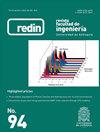哥伦比亚桑坦德可可作物产量预测的机器学习模型比较
IF 0.5
Q3 ENGINEERING, MULTIDISCIPLINARY
Revista Facultad De Ingenieria-universidad De Antioquia
Pub Date : 2020-05-15
DOI:10.19053/01211129.v29.n54.2020.10853
引用次数: 5
摘要
确定作物产量(公斤·公顷)的影响因素为有关预测和提高生产力的决策过程提供了重要信息,从而使农民有机会增加收入。本研究探讨了多种机器学习算法在可可产量预测和影响因素识别中的应用。将支持向量机(SVM)和集成学习模型(随机森林、梯度增强)与最小绝对收缩和选择算子(LASSO)回归模型进行了比较。考虑的预测因子是气候条件、可可品种、施肥水平和位于桑坦德州里奥内格罗的一种试验作物的日照。结果表明,梯度增强是最佳预测方法,决定系数(R) = 68%,平均绝对误差(MAE) = 13.32,均方根误差(RMSE) = 20.41。作物产量变化主要由收获前一个月的辐射、收获月的累积降雨量和收获前一个月的气温来解释。同样,作物产量是根据太阳照射的类型来评估的,发现收获前一个月的辐射是最多的。hlamos@uis.edu.co。ORCID: 0000-0003-1778-9768 2 M. Sc. universsidad Industrial de Santander (Bucaramanga-Santander, Colombia)。david.puentes1@correo.uis.edu.co。ORCID: 0000-0001-8178-2339 3 phd . Corporación columbiana de Investigación Agropecuaria (rionegroo - santander, Colombia)。dzarate@corpoica.org.co。哥伦比亚桑坦德可可作物产量预测的机器学习模型比较,revsta学院Ingeniería (Rev. Fac.)荷兰国际集团(Ing))。第29卷(54),e10477。2020. Tunja-Boyaca,哥伦比亚。L-ISSN: 0121-1129, e-ISSN: 2357-5328, DOI: https://doi.org/10.19053/01211129.v29.n54.2020.10853遮荫植物的影响因子。另一方面,降雨和土壤湿度是日光种植植物的决定变量,这与水分需求有关。这些结果表明,由于两种农业管理方式的产量没有显著差异,因此根据日照类型对作物进行差异化管理,以避免影响生产力。本文章由计算机程序翻译,如有差异,请以英文原文为准。
Comparison Between Machine Learning Models for Yield Forecast in Cocoa Crops in Santander, Colombia
The identification of influencing factors in crop yield (kg·ha) provides essential information for decision-making processes related to the prediction and improvement of productivity, which gives farmers the opportunity to increase their income. The current study investigates the application of multiple machine learning algorithms for cocoa yield prediction and influencing factors identification. The Support Vector Machines (SVM) and Ensemble Learning Models (Random Forests, Gradient Boosting) are compared with Least Absolute Shrinkage and Selection Operator (LASSO) regression models. The considered predictors were climate conditions, cocoa variety, fertilization level and sun exposition in an experimental crop located in Rionegro, Santander. Results showed that Gradient Boosting is the best prediction alternative with Coefficient of determination (R) = 68%, Mean Absolute Error (MAE) = 13.32, and Root Mean Square Error (RMSE) = 20.41. The crop yield variability is explained mainly by the radiation one month before harvest, the accumulated rainfall on the harvest month, and the temperature one month before harvest. Likewise, the crop yields are evaluated based on the kind of sun exposure, and it was found that radiation one month before harvest is the most 1 Ph. D. Universidad Industrial de Santander (Bucaramanga-Santander, Colombia). hlamos@uis.edu.co. ORCID: 0000-0003-1778-9768 2 M. Sc. Universidad Industrial de Santander (Bucaramanga-Santander, Colombia). david.puentes1@correo.uis.edu.co. ORCID: 0000-0001-8178-2339 3 Ph. D. Corporación Colombiana de Investigación Agropecuaria (Rionegro-Santander, Colombia). dzarate@corpoica.org.co. ORCID: 0000-0001-9630-3927 Comparison Between Machine Learning Models for Yield Forecast in Cocoa Crops in Santander, Colombia Revista Facultad de Ingeniería (Rev. Fac. Ing.) Vol. 29 (54), e10477. 2020. Tunja-Boyacá, Colombia. L-ISSN: 0121-1129, e-ISSN: 2357-5328, DOI: https://doi.org/10.19053/01211129.v29.n54.2020.10853 influential factor in shade-grown plants. On the other hand, rainfall and soil moisture are determining variables in sun-grown plants, which is associated with the water requirements. These results suggest a differentiated management for crops depending on the kind of sun exposure to avoid compromising productivity, since there is no significant difference in the yield of both agricultural managements.
求助全文
通过发布文献求助,成功后即可免费获取论文全文。
去求助
来源期刊
CiteScore
2.00
自引率
0.00%
发文量
27
审稿时长
2 months
期刊介绍:
Revista Facultad de Ingenieria started in 1984 and is a publication of the School of Engineering at the University of Antioquia.
The main objective of the journal is to promote and stimulate the publishing of national and international scientific research results. The journal publishes original articles, resulting from scientific research, experimental and or simulation studies in engineering sciences, technology, and similar disciplines (Electronics, Telecommunications, Bioengineering, Biotechnology, Electrical, Computer Science, Mechanical, Chemical, Environmental, Materials, Sanitary, Civil and Industrial Engineering).
In exceptional cases, the journal will publish insightful articles related to current important subjects, or revision articles representing a significant contribution to the contextualization of the state of the art in a known relevant topic. Case reports will only be published when those cases are related to studies in which the validity of a methodology is being proven for the first time, or when a significant contribution to the knowledge of an unexplored system can be proven.
All published articles have undergone a peer review process, carried out by experts recognized for their knowledge and contributions to the relevant field.
To adapt the Journal to international standards and to promote the visibility of the published articles; and therefore, to have a greater impact in the global academic community, after November 1st 2013, the journal will accept only manuscripts written in English for reviewing and publication.
Revista Facultad de Ingeniería –redin is entirely financed by University of Antioquia
Since 2015, every article accepted for publication in the journal is assigned a DOI number.

 求助内容:
求助内容: 应助结果提醒方式:
应助结果提醒方式:


